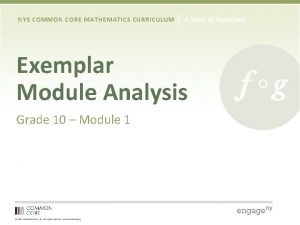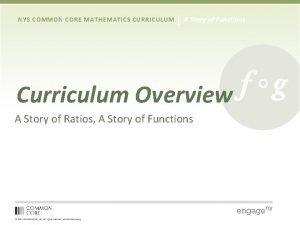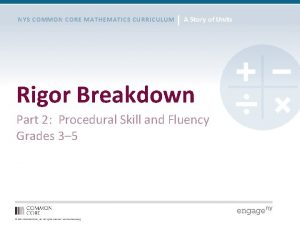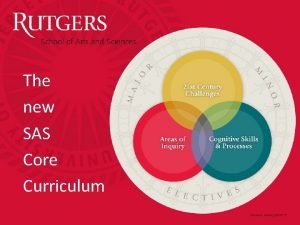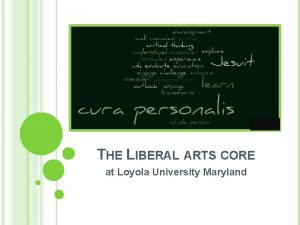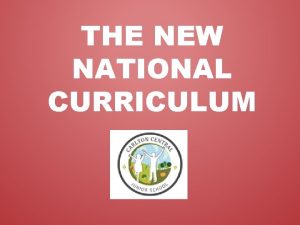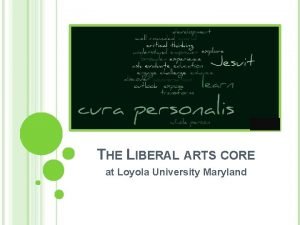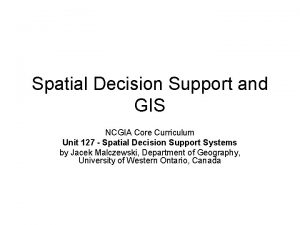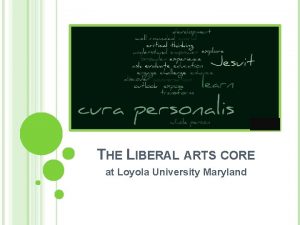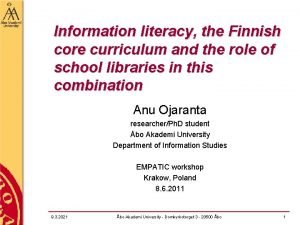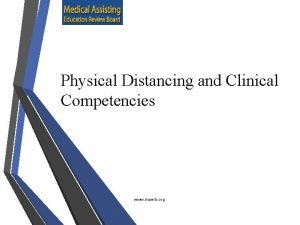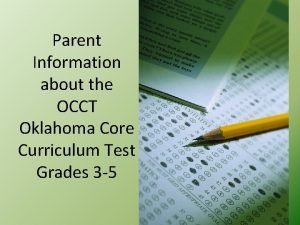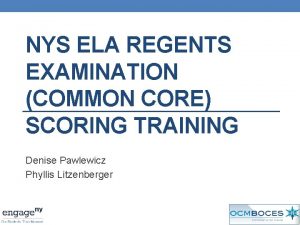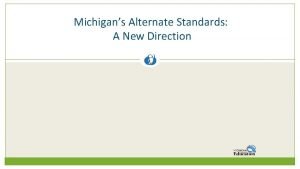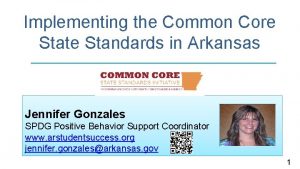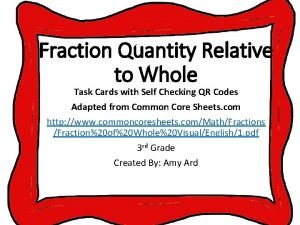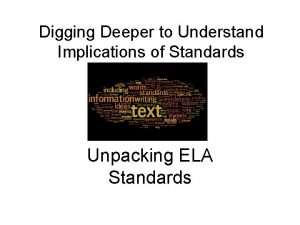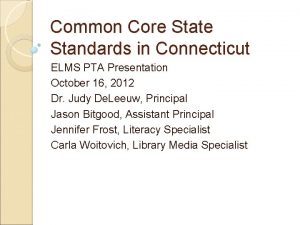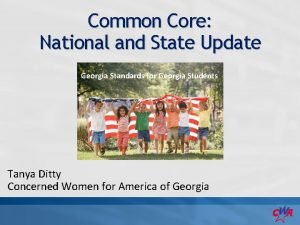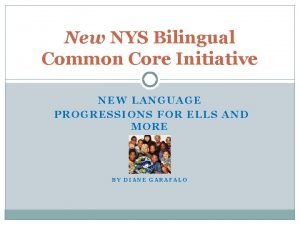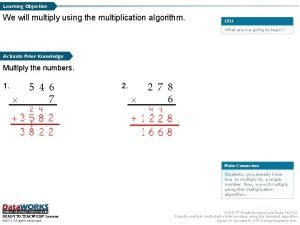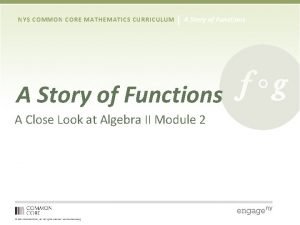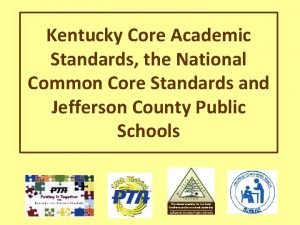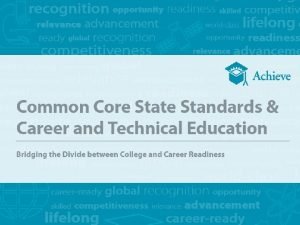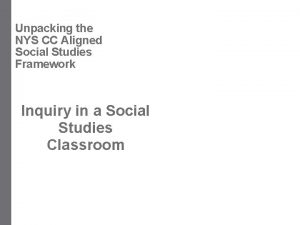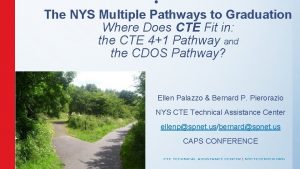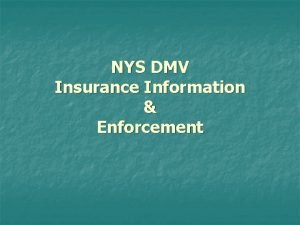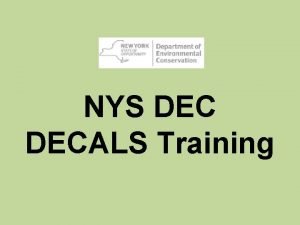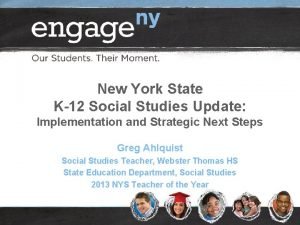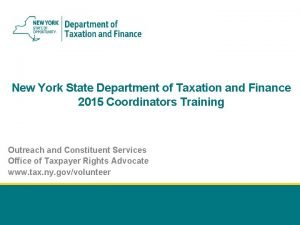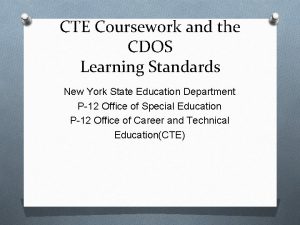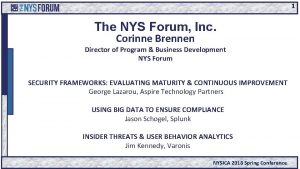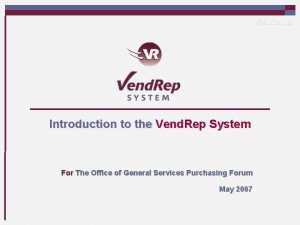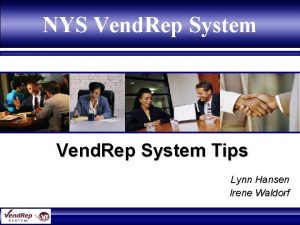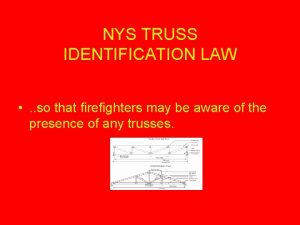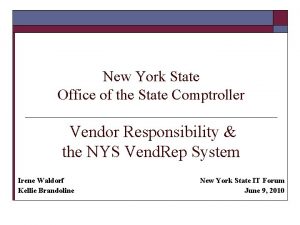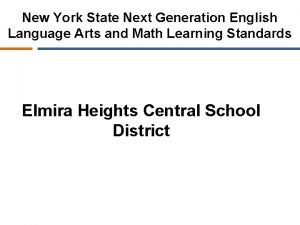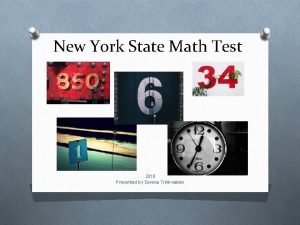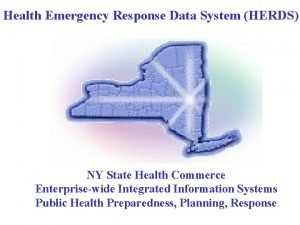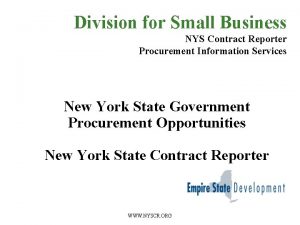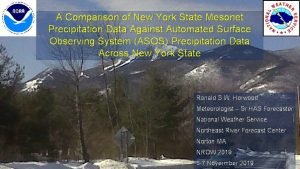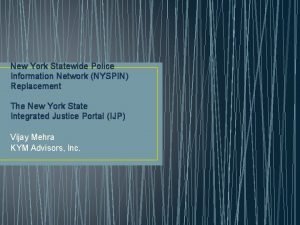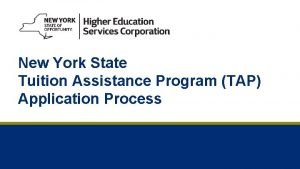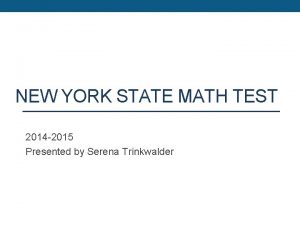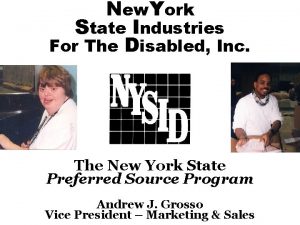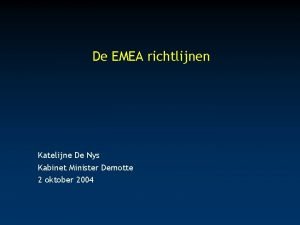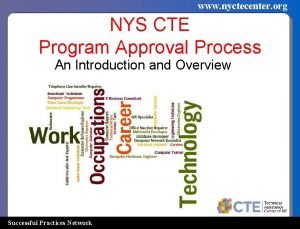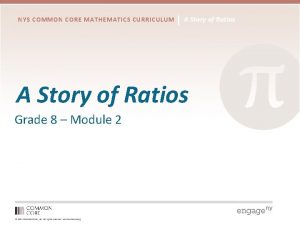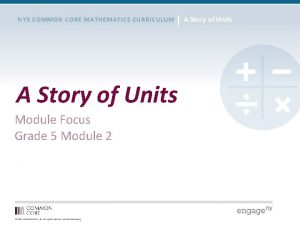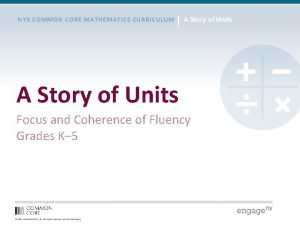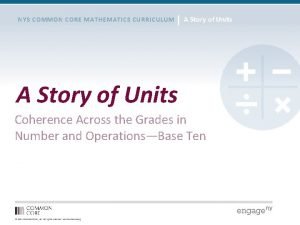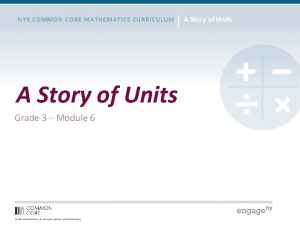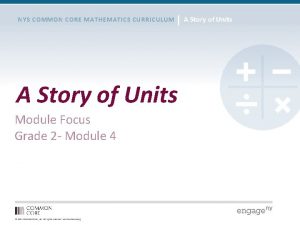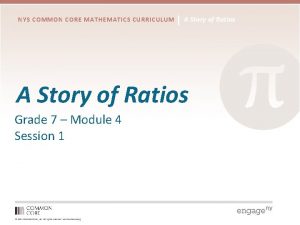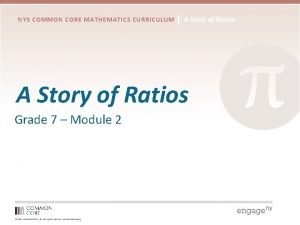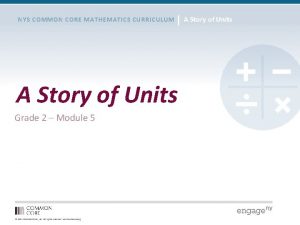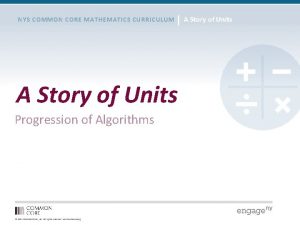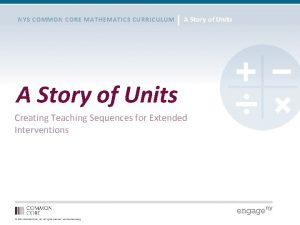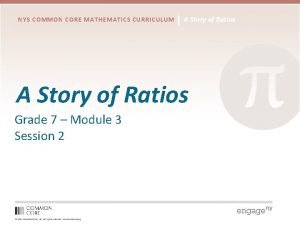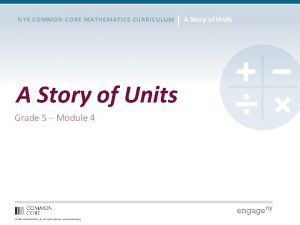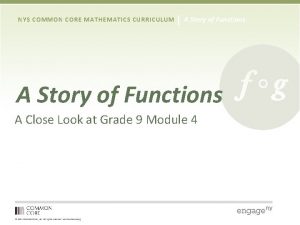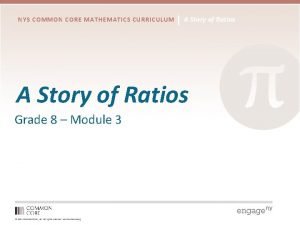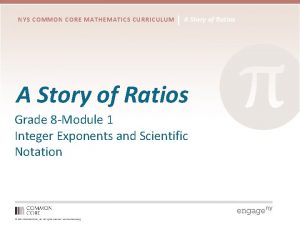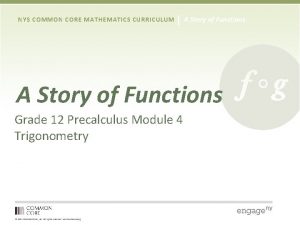NYS COMMON CORE MATHEMATICS CURRICULUM A Story of























































































- Slides: 87

NYS COMMON CORE MATHEMATICS CURRICULUM A Story of Functions A Close Look at Grade 11 Module 3 © 2012 Common Core, Inc. All rights reserved. commoncore. org

NYS COMMON CORE MATHEMATICS CURRICULUM A Story of Functions Opening Exercise I would like to assign each person in the room a unique identification number of equal digits using only the digits 0, 1, and 2. How many digits does the number need to be to ensure that each person has a unique ID number? © 2012 Common Core, Inc. All rights reserved. commoncore. org

NYS COMMON CORE MATHEMATICS CURRICULUM Participant Poll • • • Classroom teacher Math trainer Principal or school leader District representative / leader Other © 2012 Common Core, Inc. All rights reserved. commoncore. org A Story of Functions

NYS COMMON CORE MATHEMATICS CURRICULUM A Story of Functions Session Objectives • Experience and model the instructional approaches to teaching the content of Grade 11 Module 3 lessons. • Articulate how the lessons promote mastery of the focus standards and how the module addresses the major work of the grade. • Make connections from the content of previous modules and grade levels to the content of this module. © 2012 Common Core, Inc. All rights reserved. commoncore. org

NYS COMMON CORE MATHEMATICS CURRICULUM Agenda • • Overview of Module 3 Topic A Topic B Mid-Module Assessment Topic C Topic D Topic E End of Module Assessment © 2012 Common Core, Inc. All rights reserved. commoncore. org A Story of Functions

NYS COMMON CORE MATHEMATICS CURRICULUM A Story of Functions Flow of Module 3 • Topic A: Real Numbers • Topic B: Logarithms • Topic C: Exponential and Logarithmic Functions and Their Graphs • Topic D: Using Logarithms in Modeling Situations • Topic E: Geometric Series and Finance © 2012 Common Core, Inc. All rights reserved. commoncore. org

NYS COMMON CORE MATHEMATICS CURRICULUM A Story of Functions Mathematical Themes of Module 3 • Look for and make use of structure (MP 7). • Properties of exponents and logarithms are useful for rewriting expressions, solving equations, and graphing functions. • Exponential and logarithmic functions can be used to model a variety of real world situations. • An understanding of the inverse relationship between exponential and logarithmic functions is key. © 2012 Common Core, Inc. All rights reserved. commoncore. org

NYS COMMON CORE MATHEMATICS CURRICULUM A Story of Functions What prior experiences have students had? • Evaluating exponential expressions and graphing exponential functions with a domain of the integers (Algebra I Module 3) • Identifying arithmetic and geometric sequences and writing recursive and explicit formulas for the sequences (Algebra I Module 3) • Modeling data using exponential functions (Algebra I Module 3 and 5) • Selecting an appropriate function to model data (Algebra I and Algebra II) © 2012 Common Core, Inc. All rights reserved. commoncore. org

NYS COMMON CORE MATHEMATICS CURRICULUM Agenda • • Overview of Module 3 Topic A Topic B Mid-Module Assessment Topic C Topic D Topic E End of Module Assessment © 2012 Common Core, Inc. All rights reserved. commoncore. org A Story of Functions

NYS COMMON CORE MATHEMATICS CURRICULUM A Story of Functions Topic A: Real Numbers • Students extend their understanding of exponential functions to a domain of all real numbers. • Students use their prior knowledge about families of functions to graph exponential functions. • The stage is set for logarithms through exploration of base 10 exponentials and a discovery of the number e. © 2012 Common Core, Inc. All rights reserved. commoncore. org

NYS COMMON CORE MATHEMATICS CURRICULUM A Story of Functions Lessons 1: Integer Exponents • Paper folding and the power of exponential growth: • http: //ed. ted. com/lessons/how-folding-paper-can-get-you-to-themoon • Properties of exponents are addressed in this lesson. • Focus on how these properties can be used to rewrite expressions in a variety of ways rather than on the vague notion of “simplifying. ” © 2012 Common Core, Inc. All rights reserved. commoncore. org

NYS COMMON CORE MATHEMATICS CURRICULUM Lessons 1: Integer Exponents © 2012 Common Core, Inc. All rights reserved. commoncore. org A Story of Functions

NYS COMMON CORE MATHEMATICS CURRICULUM A Story of Functions Lesson 2: Base 10 and Scientific Notation • Students explore multiplying numbers by powers of 10. • Scientific notation is reviewed and connected to the properties of exponents covered in lesson 1. • We are building the foundation for understanding base 10 logarithms in Topic B. © 2012 Common Core, Inc. All rights reserved. commoncore. org

NYS COMMON CORE MATHEMATICS CURRICULUM A Story of Functions Extend the properties of exponents to rational exponents N-RN. A. 1 Explain how the definition of the meaning of rational exponents follows from extending the properties of integer exponents to those values, allowing for a notation for radicals in terms of rational exponents. For example, we define 51/3 to be the cube root of 5 because we want (51/3)3 = 5(1/3)3 to hold, so (51/3)3 must equal 5. N-RN. A. 2 Rewrite expressions involving radicals and rational exponents using the properties of exponents. © 2012 Common Core, Inc. All rights reserved. commoncore. org

NYS COMMON CORE MATHEMATICS CURRICULUM © 2012 Common Core, Inc. All rights reserved. commoncore. org A Story of Functions

NYS COMMON CORE MATHEMATICS CURRICULUM © 2012 Common Core, Inc. All rights reserved. commoncore. org A Story of Functions

NYS COMMON CORE MATHEMATICS CURRICULUM © 2012 Common Core, Inc. All rights reserved. commoncore. org A Story of Functions

NYS COMMON CORE MATHEMATICS CURRICULUM A Story of Functions Lesson 4: Properties of Exponents and Radicals • Students continue to make connections between the properties of exponents, rational exponents, and radicals. • Students interchange between radicals and rational exponents, realizing that depending on the situation one or the other may be more useful. • Notice the wording of the directions when working the exercises. © 2012 Common Core, Inc. All rights reserved. commoncore. org

NYS COMMON CORE MATHEMATICS CURRICULUM © 2012 Common Core, Inc. All rights reserved. commoncore. org A Story of Functions

NYS COMMON CORE MATHEMATICS CURRICULUM © 2012 Common Core, Inc. All rights reserved. commoncore. org A Story of Functions

NYS COMMON CORE MATHEMATICS CURRICULUM © 2012 Common Core, Inc. All rights reserved. commoncore. org A Story of Functions

NYS COMMON CORE MATHEMATICS CURRICULUM © 2012 Common Core, Inc. All rights reserved. commoncore. org A Story of Functions

NYS COMMON CORE MATHEMATICS CURRICULUM Key Points – Topic A © 2012 Common Core, Inc. All rights reserved. commoncore. org A Story of Functions

NYS COMMON CORE MATHEMATICS CURRICULUM Agenda • • Overview of Module 3 Topic A Topic B Mid-Module Assessment Topic C Topic D Topic E End of Module Assessment © 2012 Common Core, Inc. All rights reserved. commoncore. org A Story of Functions

NYS COMMON CORE MATHEMATICS CURRICULUM A Story of Functions Topic B: Logarithms • Students develop an understanding of the relationship between exponentials and logarithms. • Students explore a variety of methods for solving exponential equations. • Ultimately, students solve equations in the form abct = d by expressing the exponential equation as a logarithm (F-LE. A. 4). • Students discover basic properties of logarithms. • Why do logarithms even exist? © 2012 Common Core, Inc. All rights reserved. commoncore. org

NYS COMMON CORE MATHEMATICS CURRICULUM A Story of Functions Lesson 7: Bacteria and Exponential Growth © 2012 Common Core, Inc. All rights reserved. commoncore. org

NYS COMMON CORE MATHEMATICS CURRICULUM A Story of Functions Lesson 7: Bacteria and Exponential Growth © 2012 Common Core, Inc. All rights reserved. commoncore. org

NYS COMMON CORE MATHEMATICS CURRICULUM A Story of Functions Lesson 8: The “What. Power” Function • Work the opening exercise. • Students are making sense of the definition of a logarithm through a more intuitive function. • Students continue investigating the “What. Power” function coming to the realization that bases of 0 and 1 do not make sense and negative bases are only valid sometimes. • Students also make sense of the domain of the “What. Power” function, realizing that only inputs greater than 0 have a real output. © 2012 Common Core, Inc. All rights reserved. commoncore. org

NYS COMMON CORE MATHEMATICS CURRICULUM A Story of Functions Lesson 8: The “What. Power” Function © 2012 Common Core, Inc. All rights reserved. commoncore. org

NYS COMMON CORE MATHEMATICS CURRICULUM Rapid White Board Exchange Evaluate each logarithm © 2012 Common Core, Inc. All rights reserved. commoncore. org A Story of Functions

NYS COMMON CORE MATHEMATICS CURRICULUM A Story of Functions Opening Exercise I would like to assign each person in the room an identification number using only the digits 0, 1, and 2. How many digits does the number need to be to ensure that each person has a unique ID number? © 2012 Common Core, Inc. All rights reserved. commoncore. org

NYS COMMON CORE MATHEMATICS CURRICULUM A Story of Functions Lesson 9: Logarithms – How Many Digits Do You Need? • Why are social security numbers 9 digits? • How do we know that 9 digits are enough for each person in the U. S. to have a unique number? • Would 8 digits be enough to ensure each person had a unique number? • At what point would we need to increase to 10 digits? © 2012 Common Core, Inc. All rights reserved. commoncore. org

NYS COMMON CORE MATHEMATICS CURRICULUM A Story of Functions Lesson 10: Building Logarithmic Tables • Students explore base 10 logs first through a “squeeze” process and then using the log button. • Emphasize the meaning of the output on the calculator. © 2012 Common Core, Inc. All rights reserved. commoncore. org

NYS COMMON CORE MATHEMATICS CURRICULUM A Story of Functions Lesson 11: The Most Important Property of Logarithms • Students build on the properties discovered in lesson 10. • Emphasis on Math Practice 8: • Look for and express regularity in repeated reasoning. © 2012 Common Core, Inc. All rights reserved. commoncore. org

NYS COMMON CORE MATHEMATICS CURRICULUM A Story of Functions Lesson 12: Properties of Logarithms © 2012 Common Core, Inc. All rights reserved. commoncore. org

NYS COMMON CORE MATHEMATICS CURRICULUM A Story of Functions Lesson 13: Changing the Base • Why does the calculator only have the base 10 and base e logarithms? • How would one evaluate a base 2 logarithm on the calculator? • Students develop and then use the change of base formula for logarithms. © 2012 Common Core, Inc. All rights reserved. commoncore. org

NYS COMMON CORE MATHEMATICS CURRICULUM A Story of Functions Lesson 14: Solving Logarithmic Equations • Emphasize: • looking for and making use of structure (MP 7). • checking for extraneous solutions. • Share different approaches and discuss advantages and disadvantages. (MP 3) © 2012 Common Core, Inc. All rights reserved. commoncore. org

NYS COMMON CORE MATHEMATICS CURRICULUM A Story of Functions Lesson 15: Why Were Logarithms Developed? © 2012 Common Core, Inc. All rights reserved. commoncore. org

NYS COMMON CORE MATHEMATICS CURRICULUM A Story of Functions Key Points – Topic B • Logarithmic functions have an important historical context. • Logarithms help us make sense of very large and very small numbers. • Logarithms give us a way of solving exponential equations. • Properties of logarithms are essential for evaluating logarithms and solving exponential or logarithmic equations. © 2012 Common Core, Inc. All rights reserved. commoncore. org

NYS COMMON CORE MATHEMATICS CURRICULUM Agenda • • Overview of Module 3 Topic A Topic B Mid-Module Assessment Topic C Topic D Topic E End of Module Assessment © 2012 Common Core, Inc. All rights reserved. commoncore. org A Story of Functions

NYS COMMON CORE MATHEMATICS CURRICULUM Mid-Module Assessment Work with a partner on this assessment © 2012 Common Core, Inc. All rights reserved. commoncore. org A Story of Functions

NYS COMMON CORE MATHEMATICS CURRICULUM Scoring the Assessment © 2012 Common Core, Inc. All rights reserved. commoncore. org A Story of Functions

NYS COMMON CORE MATHEMATICS CURRICULUM Agenda • • Overview of Module 3 Topic A Topic B Mid-Module Assessment Topic C Topic D Topic E End of Module Assessment © 2012 Common Core, Inc. All rights reserved. commoncore. org A Story of Functions

NYS COMMON CORE MATHEMATICS CURRICULUM A Story of Functions Topic C: Exponential and Logarithmic Functions and Their Graphs • Students recognize that exponential functions are defined for all real numbers and logarithmic functions are defined for all positive numbers. • Students explore the idea that exponential and logarithmic functions are inverses of each other. • Students connect the properties of logarithms from Topic B to transformations of the graphs of logarithmic functions. © 2012 Common Core, Inc. All rights reserved. commoncore. org

NYS COMMON CORE MATHEMATICS CURRICULUM A Story of Functions Lesson 16: Rational and Irrational Numbers • On a number line extending infinitely in both directions, are there more: • integers or natural numbers? • rational numbers or integers? • irrational numbers or rational numbers? © 2012 Common Core, Inc. All rights reserved. commoncore. org

NYS COMMON CORE MATHEMATICS CURRICULUM A Story of Functions Lesson 16: Rational and Irrational Numbers • In topic A, we expanded the domain of exponential functions to include all real numbers. • Since we know that we can evaluate an exponential function for both rational and irrational numbers, it is logical that logarithms can have an output that is either rational or irrational. • Most logarithms (even of rational numbers) are irrational. © 2012 Common Core, Inc. All rights reserved. commoncore. org

NYS COMMON CORE MATHEMATICS CURRICULUM A Story of Functions Lesson 17: Graphing the Logarithm Function © 2012 Common Core, Inc. All rights reserved. commoncore. org

NYS COMMON CORE MATHEMATICS CURRICULUM A Story of Functions Lesson 17: Graphing the Logarithm Function © 2012 Common Core, Inc. All rights reserved. commoncore. org

NYS COMMON CORE MATHEMATICS CURRICULUM © 2012 Common Core, Inc. All rights reserved. commoncore. org A Story of Functions

NYS COMMON CORE MATHEMATICS CURRICULUM A Story of Functions Lesson 18: Graphs of Exponential Functions and Logarithmic Functions • Students realize that if the graph of an exponential function is reflected across the line y = x the graph produced is a logarithmic function. • Students explore the relationship between ordered pairs on the exponential curve and the logarithmic curve. • Students use this relationship to make sense of the domain and range of each function as well as the end behavior. © 2012 Common Core, Inc. All rights reserved. commoncore. org

NYS COMMON CORE MATHEMATICS CURRICULUM A Story of Functions Lesson 19: The Inverse Relationship Between Logarithmic and Exponential Functions F-BF. B. 4: Find inverse functions. a. Solve an equation of the form f(x) = c for a simple function f that has an inverse and write an expression for the inverse. For example, f(x) =2 x 3 or f(x) = (x+1)/(x-1) for x ≠ 1. b. (+) Verify by composition that one function is the inverse of another. c. (+) Read values of an inverse function from a graph or a table, given that the function has an inverse. d. (+) Produce an invertible function from a non-invertible function by restricting the domain. © 2012 Common Core, Inc. All rights reserved. commoncore. org

NYS COMMON CORE MATHEMATICS CURRICULUM A Story of Functions Lesson 19: The Inverse Relationship Between Logarithmic and Exponential Functions F-BF. B. 5 (+) Understand the inverse relationship between exponents and logarithms and use this relationship to solve problems involving logarithms and exponents. F-LE. A. 4 For exponential models, express as a logarithm the solution to abct = d where a, c, and d are numbers and the base b is 2, 10, or e; evaluate the logarithm using technology. © 2012 Common Core, Inc. All rights reserved. commoncore. org

NYS COMMON CORE MATHEMATICS CURRICULUM A Story of Functions Lesson 20: Transformations of the Graphs of Logarithmic and Exponential Functions • Student Outcomes • Students study transformations of the graphs of logarithmic functions. • Students use the properties of logarithms and exponents to produce equivalent forms of exponential and logarithmic expressions. In particular, they notice that different types of transformations can produce the same graph due to these properties. • Revisits transformations to produce exponential and logarithmic graphs. • Connects transformations of graphs of functions to properties of logarithms. © 2012 Common Core, Inc. All rights reserved. commoncore. org

NYS COMMON CORE MATHEMATICS CURRICULUM A Story of Functions Lesson 20: Transformations of the Graphs of Logarithmic and Exponential Functions © 2012 Common Core, Inc. All rights reserved. commoncore. org

NYS COMMON CORE MATHEMATICS CURRICULUM A Story of Functions Lesson 21: The Graph of the Natural Logarithm Function © 2012 Common Core, Inc. All rights reserved. commoncore. org

NYS COMMON CORE MATHEMATICS CURRICULUM A Story of Functions Lesson 21: The Graph of the Natural Logarithm Function © 2012 Common Core, Inc. All rights reserved. commoncore. org

NYS COMMON CORE MATHEMATICS CURRICULUM A Story of Functions Lesson 22: Choosing a Model • • At his point, students have modeled data using linear, quadratic, exponential, and sinusoidal function. How do we know which function is an appropriate model based on a context? © 2012 Common Core, Inc. All rights reserved. commoncore. org

NYS COMMON CORE MATHEMATICS CURRICULUM A Story of Functions Key Points – Topic C • A logarithmic function is the inverse of an exponential function. • Properties of logarithms and exponents are useful for graphing transformations of logarithmic and exponential functions. • Using the change of base formula, any logarithmic function can be rewritten as a vertical scaling of the natural logarithm function (or any other base logarithm). © 2012 Common Core, Inc. All rights reserved. commoncore. org

NYS COMMON CORE MATHEMATICS CURRICULUM Agenda • • Overview of Module 3 Topic A Topic B Mid-Module Assessment Topic C Topic D Topic E End of Module Assessment © 2012 Common Core, Inc. All rights reserved. commoncore. org A Story of Functions

NYS COMMON CORE MATHEMATICS CURRICULUM A Story of Functions Topic D: Using Logarithms in Modeling Situations • Students create models for contexts that involve exponential growth and decay. • Problems similar to those studied in Algebra I Module 3 are reexamined now that students have the logarithm as a tool for solving the exponential equations that arise. • Students connect geometric sequences to exponential growth and decay which serves as a lead-in to the study of geometric series and finance in Topic E. © 2012 Common Core, Inc. All rights reserved. commoncore. org

NYS COMMON CORE MATHEMATICS CURRICULUM A Story of Functions Lesson 23: Bean Counting • Read the student outcomes and then look at the exit ticket. Identify the key takeaways of the lesson. • Read the lesson notes and opening. • Work through Mathematical Modeling Exercise 1 and then read the discussion that follows. • Work through Mathematical Modeling Exercise 2 and then read the discussion that follows. • Read through the closing and scan the problem set. © 2012 Common Core, Inc. All rights reserved. commoncore. org

NYS COMMON CORE MATHEMATICS CURRICULUM A Story of Functions Lesson 24: Solving Exponential Equations © 2012 Common Core, Inc. All rights reserved. commoncore. org

NYS COMMON CORE MATHEMATICS CURRICULUM A Story of Functions Lesson 25: Geometric Sequences and Exponential Growth and Decay © 2012 Common Core, Inc. All rights reserved. commoncore. org

NYS COMMON CORE MATHEMATICS CURRICULUM A Story of Functions Lesson 25: Geometric Sequences and Exponential Growth and Decay © 2012 Common Core, Inc. All rights reserved. commoncore. org

NYS COMMON CORE MATHEMATICS CURRICULUM A Story of Functions Lesson 25: Geometric Sequences and Exponential Growth and Decay • Algebra I Module 3 Lesson 6: © 2012 Common Core, Inc. All rights reserved. commoncore. org

NYS COMMON CORE MATHEMATICS CURRICULUM A Story of Functions Lesson 25: Geometric Sequences and Exponential Growth and Decay © 2012 Common Core, Inc. All rights reserved. commoncore. org

NYS COMMON CORE MATHEMATICS CURRICULUM Lesson 26: Percent of Change © 2012 Common Core, Inc. All rights reserved. commoncore. org A Story of Functions

NYS COMMON CORE MATHEMATICS CURRICULUM A Story of Functions Lesson 27: Modeling with Exponential Functions • Students revisit a problem they explored in Algebra I Module 3 Lesson 6 – creating a function to model the U. S. population. • Students create a model using a variety of techniques. • Logarithms are used to solve exponential equations where in Algebra I we estimated either graphically or numerically to solve. © 2012 Common Core, Inc. All rights reserved. commoncore. org

NYS COMMON CORE MATHEMATICS CURRICULUM A Story of Functions Lesson 28: Newton’s Law of Cooling, Revisited © 2012 Common Core, Inc. All rights reserved. commoncore. org

NYS COMMON CORE MATHEMATICS CURRICULUM A Story of Functions Lesson 28: Newton’s Law of Cooling, Revisited © 2012 Common Core, Inc. All rights reserved. commoncore. org

NYS COMMON CORE MATHEMATICS CURRICULUM A Story of Functions Key Points – Topic D • When modeling with exponential functions, logarithms are useful for solving the exponential equations that arise. • The number e appears in many applications of exponential functions. • There is a powerful connection between geometric sequences, exponential functions, and logarithms. • We will continue to explore applications of exponentials and logarithms in Topic E. © 2012 Common Core, Inc. All rights reserved. commoncore. org

NYS COMMON CORE MATHEMATICS CURRICULUM Agenda • • Overview of Module 3 Topic A Topic B Mid-Module Assessment Topic C Topic D Topic E End of Module Assessment © 2012 Common Core, Inc. All rights reserved. commoncore. org A Story of Functions

NYS COMMON CORE MATHEMATICS CURRICULUM A Story of Functions Topic E: Geometric Series and Finance • Students learn about series and use sigma notation for the first time. • Students apply their knowledge of geometric sequences to various financial contexts. • The emphasis in this topic is on MP 4 – Modeling with mathematics. © 2012 Common Core, Inc. All rights reserved. commoncore. org

NYS COMMON CORE MATHEMATICS CURRICULUM A Story of Functions Lesson 29: The Mathematics Behind a Structured Savings Plan © 2012 Common Core, Inc. All rights reserved. commoncore. org

NYS COMMON CORE MATHEMATICS CURRICULUM A Story of Functions Lesson 29: The Mathematics Behind a Structured Savings Plan © 2012 Common Core, Inc. All rights reserved. commoncore. org

NYS COMMON CORE MATHEMATICS CURRICULUM A Story of Functions Lesson 29: The Mathematics Behind a Structured Savings Plan © 2012 Common Core, Inc. All rights reserved. commoncore. org

NYS COMMON CORE MATHEMATICS CURRICULUM A Story of Functions Lesson 30: Buying a Car • Students derive a formula for the monthly payment on a car loan using the formula for the sum of a finite geometric series. • Students complete an open-ended modeling task where they research the price of a potential car purchase and from there calculate their loan. • Students realize there is more to consider when purchasing a car than just the selling price. © 2012 Common Core, Inc. All rights reserved. commoncore. org

NYS COMMON CORE MATHEMATICS CURRICULUM Lesson 31: Credit Cards © 2012 Common Core, Inc. All rights reserved. commoncore. org A Story of Functions

NYS COMMON CORE MATHEMATICS CURRICULUM Lesson 32: Buying a House © 2012 Common Core, Inc. All rights reserved. commoncore. org A Story of Functions

NYS COMMON CORE MATHEMATICS CURRICULUM A Story of Functions Lesson 33: The Million Dollar Problem • How can I accumulate $1, 000 in assets? • Students apply knowledge from the previous lessons to explore this question. • Students consider savings, property which generally appreciates in value, and vehicles which depreciate in value. © 2012 Common Core, Inc. All rights reserved. commoncore. org

NYS COMMON CORE MATHEMATICS CURRICULUM A Story of Functions Key Points – Topic E • Geometric sequences and series are prevalent in finance calculations. • Good modeling problems are often open-ended and sometimes messy! • Technology is useful for exploring a problem graphically or numerically. © 2012 Common Core, Inc. All rights reserved. commoncore. org

NYS COMMON CORE MATHEMATICS CURRICULUM Key Points – Module 3 Lessons © 2012 Common Core, Inc. All rights reserved. commoncore. org A Story of Functions

NYS COMMON CORE MATHEMATICS CURRICULUM Agenda • • Overview of Module 3 Topic A Topic B Mid-Module Assessment Topic C Topic D Topic E End of Module Assessment © 2012 Common Core, Inc. All rights reserved. commoncore. org A Story of Functions

NYS COMMON CORE MATHEMATICS CURRICULUM End-of-Module Assessment Work with a partner on this assessment © 2012 Common Core, Inc. All rights reserved. commoncore. org A Story of Functions

NYS COMMON CORE MATHEMATICS CURRICULUM Scoring the Assessment © 2012 Common Core, Inc. All rights reserved. commoncore. org A Story of Functions

NYS COMMON CORE MATHEMATICS CURRICULUM A Story of Functions Key Points – End-of-Module Assessment • End of Module assessment are designed to assess all standards of the module (at least at the cluster level) with an emphasis on assessing thoroughly those presented in the second half of the module. • Recall, as much as possible, assessment items are designed to asses the standards while emulating PARCC Type 2 and Type 3 tasks. • Recall, rubrics are designed to inform each district / school / teacher as they make decisions about the use of assessments in the assignment of grades. © 2012 Common Core, Inc. All rights reserved. commoncore. org

NYS COMMON CORE MATHEMATICS CURRICULUM A Story of Functions Biggest Takeaway What are your biggest takeaways from the study of Module 3? How can you support successful implementation of these materials at your schools given your role as a teacher, trainer, school or district leader, administrator or other representative? © 2012 Common Core, Inc. All rights reserved. commoncore. org
 Nys common core mathematics
Nys common core mathematics Nys common core mathematics curriculum
Nys common core mathematics curriculum Nys common core mathematics curriculum
Nys common core mathematics curriculum Inner core and outer core
Inner core and outer core The strong lower part of the mantle
The strong lower part of the mantle Layers of earth from most dense to least dense
Layers of earth from most dense to least dense Core rigidity
Core rigidity Sas core classes
Sas core classes Loyola maryland core curriculum
Loyola maryland core curriculum Chinese national curriculum core subjects
Chinese national curriculum core subjects Non statutory subjects national curriculum
Non statutory subjects national curriculum Academic worksheets loyola maryland
Academic worksheets loyola maryland Ota resident lectures
Ota resident lectures Iowa core curriculum
Iowa core curriculum Harvard core curriculum
Harvard core curriculum Ncgia core curriculum
Ncgia core curriculum Kidney biopsy core curriculum
Kidney biopsy core curriculum National core curriculum
National core curriculum Aasc loyola
Aasc loyola Ung core plan of study
Ung core plan of study What is core curriculum
What is core curriculum Maerb
Maerb Oklahoma core curriculum tests
Oklahoma core curriculum tests Ota resident lectures
Ota resident lectures Common core state standards pa
Common core state standards pa Essential elements standards
Essential elements standards Regents text analysis
Regents text analysis Michigan essential elements
Michigan essential elements Common core standards arkansas
Common core standards arkansas Common core sheets.com
Common core sheets.com Unpacking common core standards template
Unpacking common core standards template Common core state standards ct
Common core state standards ct Common core standards georgia
Common core standards georgia Common core formative assessments
Common core formative assessments Utah common core math
Utah common core math 4th grade math jeopardy common core
4th grade math jeopardy common core New language arts progressions
New language arts progressions Common core lattice multiplication
Common core lattice multiplication Common core state standards missouri
Common core state standards missouri Ela standards kansas
Ela standards kansas Lesson 4 from circle-ometry to trigonometry
Lesson 4 from circle-ometry to trigonometry Common core standards kentucky
Common core standards kentucky Common core ela assessments
Common core ela assessments Common career technical core
Common career technical core Greatest common factor least common multiple
Greatest common factor least common multiple Common anode and common cathode
Common anode and common cathode Hcf 60 and 72
Hcf 60 and 72 Factors of 54
Factors of 54 Factors of 18
Factors of 18 Highest common factors and lowest common multiples
Highest common factors and lowest common multiples God's big story curriculum
God's big story curriculum Iowa social studies standards unpacked
Iowa social studies standards unpacked Nys graduation pathways
Nys graduation pathways Nys beaks of finches lab
Nys beaks of finches lab Nys omh pmcs training
Nys omh pmcs training Curol definition
Curol definition Earth science lab practical review
Earth science lab practical review Nys ogs design and construction
Nys ogs design and construction Nys dmv insurance codes
Nys dmv insurance codes Nys dec decals
Nys dec decals Community development program
Community development program Engage ny.org
Engage ny.org Nys ela test 2016
Nys ela test 2016 5184352990
5184352990 Nys cte standards
Nys cte standards Maria nys
Maria nys Nys
Nys Vendor rep system
Vendor rep system Nys vend rep
Nys vend rep Nys truss identification law
Nys truss identification law Nyspayrollonline
Nyspayrollonline Nys vend rep system
Nys vend rep system Nys ela standards next generation
Nys ela standards next generation Nys test 2018
Nys test 2018 Ny state ela test 2018
Ny state ela test 2018 Herds nys
Herds nys Nys contract reporter
Nys contract reporter Nys mesonet now
Nys mesonet now Nys dcjs forms
Nys dcjs forms Nys diffusion through a membrane lab answers
Nys diffusion through a membrane lab answers Nys dcjs portal
Nys dcjs portal Application for tap
Application for tap Nys math test 2014
Nys math test 2014 New york state industries
New york state industries Jobzone ny
Jobzone ny Katelijne de nys
Katelijne de nys Nysed cte program approval
Nysed cte program approval Nys dept of homeland security
Nys dept of homeland security
